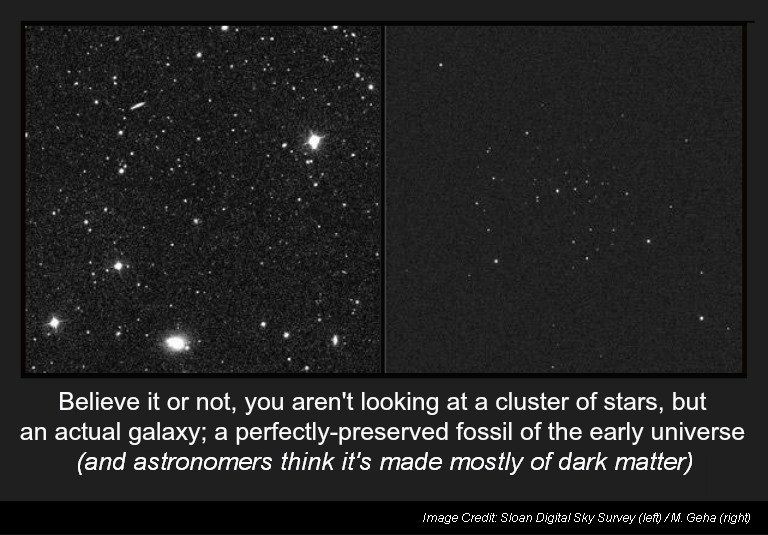

There’s something fascinating about Segue 1, a galaxy first noticed in 2006 by the Sloan Digital Sky Survey. From the beginning, this patch of sky was puzzling to astronomers because despite it being only 75,000 light years away, the stars were extremely dim. A year later in 2007, Dr. Marla Geha of Yale University looked at this section of space in more detail. Her team concluded that Segue 1 is among the oldest galaxies in the universe! The stars contained within are billions upon billions of years old, harking back the first moments in history when galaxies first emerged.
Segue 1, which is situated in the constellation Leo, is exclusive for a couple reasons. First off, it only contains around a thousand stars, so it’s pretty puny dwarf galaxy. In comparison, our Milky Way has far more stars, around 400 billion. Segue 1, on the other hand, is mostly comprised of dark matter. Its overall mass is thousands of times greater than what can be accounted for based on stars alone! It isn’t just the lack of stars that makes Segue 1 so alluring though, or its abundance of dark matter; what really sets it apart from other dwarf galaxies is its chemical composition.
THE CAUSALITIES OF THE RED-GIANT:
In an article published in the Astrophysical Journal titled, “Segue 1: An Unevolved Fossil Galaxy From the Early Universe”(arXiv version), a team of astronomers – led by Anna Frebel, from the Department of Physics at MIT – detail the unique attributes of this ancient collection of stars. With the help of the Magellan Telescope in Chile and the Keck Observatory in Hawaii, the team members were able to study a few of the brightest red giants in the galaxy.
By reading the spectrum of light emitted from the red giants, it was concluded that there is an extreme lack of metallic elements present within the galaxy. This finding was perplexing because of the galaxy’s age. Surely it should have had enough time to produce an abundance of heavy elements, however, very few were found.
Nebulae are the breeding grounds of stellar evolution. Clouds of gas and dust coalesce with the help of gravity to eventually start the fusion process of hydrogen into helium. After a billion or so years of fusion, the star generally explodes as a supernova; spewing its material out into the universe to start the process over again. However, due to the lack of heavy elements, Frebel and her team have concluded that the stars within this galaxy never matured.
FROM A SEED BLOOMS A GARDEN:

Due to the properties of fusion, heavy elements are usually formed in stars that are older and more massive. Stellar furnaces convert simple elements into heavier ones by fusing atomic nuclei; eventually it maxes out when the core begins to fuse into iron. The overall chemical fingerprint of Segue 1 shows it contains about 1/2,500th of the iron our Sun does, only a few dozen such stars have ever been discovered that fit this criteria to a point.
Dwarf galaxies are common and provide value because they don’t experience the same extensive evolution as their larger counterparts do. In other words, they don’t go through multiple generations of supernovae/nebulae cycles. Due to this, they are considered relics of earlier times and hold more clues to the state of the universe during those points than modern renderings ever could. These small galaxies may even influence the formation of larger ones.
For Segue 1 specifically, it is believed that the elements with a weight higher than helium are the result of a limited amount of supernova explosions. Until we find more galaxies like it. we can only speculate as to why its development stalled. What we do know is that Segue 1 was born near the beginning of time and only progressed for a few generations; its like looking into a time capsule of the early universe!
Cassidi also writes for his own blog. Check it out here.